

Native Teaching Aids. » Native American Activism: 1960s to Present Zinn Education Project. The month of November is often the only time students learn about Native Americans, and usually in the past tense or as helpless “wards of the state.”
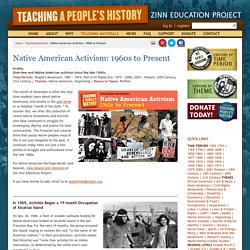
To counter this, we offer this collection of recent Native movements and activists who have continued to struggle for sovereignty, dignity, and justice for their communities. The financial and colonial drive that usurps Native peoples ways of life is not just relegated to the past; it continues today. Here are just a few stories of struggle and achievement since the late 1960s. For Native American Heritage Month (and beyond), view lessons and resources at the Zinn Education Project. If you have stories to add, email us at zep@zinnedproject.org. In 1969, Activists Began a 19-month Occupation of Alcatraz Island On Nov. 20, 1969, a fleet of wooden sailboats holding 90 Native Americans landed on Alcatraz Island in the San Francisco Bay.
American Indian College Fund. Tribal colleges provide students with access to an affordable higher education, along with important services such as GED coursework, day care, health centers, libraries, computer centers, language preservation classes, community activities, and lifelong learning programs.
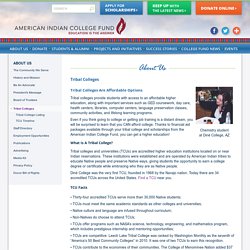
Even if you think going to college or getting job training is a distant dream, you will be surprised to learn that you CAN afford college. Thanks to financial aid packages available through your tribal college and scholarships from the American Indian College Fund, you can get a higher education! What Is A Tribal College? Tribal colleges and universities (TCUs) are accredited higher education institutions located on or near Indian reservations. These institutions were established and are operated by American Indian tribes to educate Native people and preserve Native ways, giving students the opportunity to earn a college degree or certificate while embracing who they are as Native people.
Cherokee_blood_why_do_so_many_americans_believe_they_have_cherokee_ancestry.single. Photo courtesy Carol M.
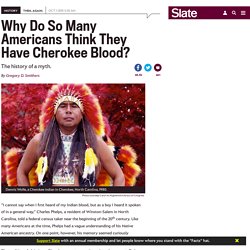
Blackhorse: 'Native American' or 'American Indian'? 5 More Native Voices Respond. Recently I submitted an article of interviews with six prominent Native people throughout the nation on the subject of naming.
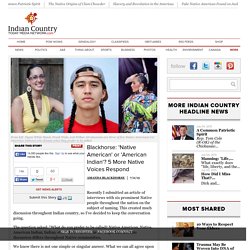
This created much discussion throughout Indian country, so I’ve decided to keep the conversation going. The question asked: “What do you prefer to be called? Native American, Native, American Indian, Indian, etc.?” References of us are important and this discussion differs throughout Native communities. We know there is not one simple or singular answer. Carlisle Indian School Digital Resource Center. Native Lit Bibliographies. Off the Literary Reservation. “What does it mean when you never see yourself in the reading you are provided at school?

ASAIL. The Map Of Native American Tribes You've Never Seen Before : Code Switch. Aaron Carapella, a self-taught mapmaker in Warner, Okla., has designed a map of Native American tribes showing their locations before first contact with Europeans.
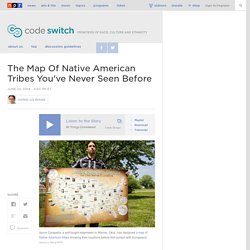
Hansi Lo Wang/NPR hide caption itoggle caption Hansi Lo Wang/NPR. The Invasion of America. The Invasion of America: How the United States Took Over an Eighth of the World. » The Cherokee/Seminole Removal Role Play Zinn Education Project. In her book A Century of Dishonor, published in 1881, Helen Hunt Jackson wrote, “There will come a time in the remote future when, to the student of American history [the Cherokee removal] will seem well-nigh incredible.”
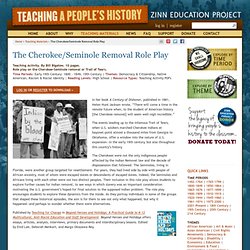
The events leading up to the infamous Trail of Tears, when U.S. soldiers marched Cherokee Indians at bayonet-point almost a thousand miles from Georgia to Oklahoma, offer a window into the nature of U.S. expansion—in the early 19th century, but also throughout this country’s history. What if people told European history like they told Native American history? The first immigrants to Europe arrived thousands of years ago from central Asia.

Most pre-contact Europeans lived together in small villages. Because the continent was very crowded, their lives were ruled by strict hierarchies within the family and outside it to control resources. Europe was highly multi-ethnic, and most tribes were ruled by hereditary leaders who commanded the majority “commoners.” These groups were engaged in near constant warfare.Pre-contact Europeans wore clothing made of natural materials such as animal skin and plant and animal-based textiles. Women wore long dresses and covered their hair, and men wore tunics and leggings. Interview with Sherman Alexie. BILL MOYERS: Welcome.

American Experience. THE VIRTUAL MUSEUM OF MÉTIS HISTORY AND CULTURE. Carlisle Indian Industrial School History. Note: I use the term "Indian" throughout this article to identify the peoples of the various autochthonous nations within the U.S. borders, who were affected by and recruited for the Indian School experiment, in keeping with the written accounts of the historic period during the school's existence.
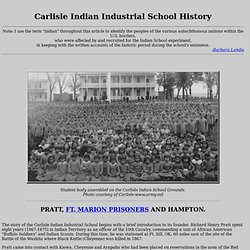
Student body assembled on the Carlisle Indian School Grounds. Photo courtesy of Carlisle-www.army.mil. Native History: Dawes Act Signed Into Law to 'Civilize' Indians. This Date in Native History: On February 8, 1887, U.S. President Grover Cleveland signed the Dawes Severalty Act into law, introducing private land ownership to American Indians.